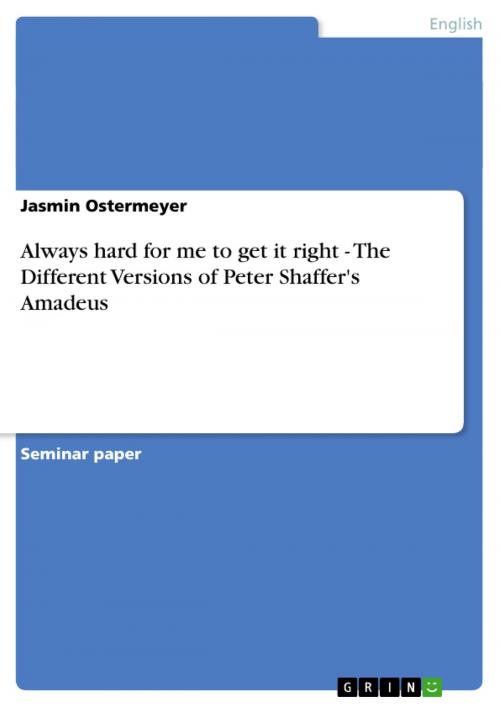Always hard for me to get it right - The Different Versions of Peter Shaffer's Amadeus
The Different Versions of Peter Shaffer's Amadeus
Fiction & Literature, Literary Theory & Criticism, British| Author: | Jasmin Ostermeyer | ISBN: | 9783638453448 |
| Publisher: | GRIN Publishing | Publication: | January 10, 2006 |
| Imprint: | GRIN Publishing | Language: | English |
| Author: | Jasmin Ostermeyer |
| ISBN: | 9783638453448 |
| Publisher: | GRIN Publishing |
| Publication: | January 10, 2006 |
| Imprint: | GRIN Publishing |
| Language: | English |
Seminar paper from the year 2005 in the subject English Language and Literature Studies - Literature, grade: 2,0, University of Hannover, 11 entries in the bibliography, language: English, abstract: Indeed, sometimes I wonder at those writers who display no desire to alter anything when work is revived. And sometimes, too, I envy their seeming certitude - or even their indifference, which may be a form of instinctive wisdom! Peter Shaffer is certainly none of those writers who do not feel the desire to alter their work. There are six different versions of his playAmadeuswhich have been produced on stage and screen since 1979, whenAmadeusmade its first appearance in the National Theatre of Great Britain, London. The latest version of Shaffer's play was published in 1999, after being revived and staged in London and New York. Writing and, mainly, re-writing Amadeus has been a process of 20 years in which Shaffer changed not only some aspects of the plot but in the first place of characters and their meaning. The most prominent alternations can be seen at the end of the second act, the final confrontation of the two main characters, Antonio Salieri and Wolfgang Amadeus Mozart. It is especially this scene of their last meeting that Shaffer felthard [...] to get right, because he considered it as the play's structural climax whereas the historical truth - Salieri survived Mozart 34 years,retired, replaced and essentially rejected3- was anticlimactic. This essay shall investigate the alternations of the last confrontation between the two characters and their impact on one of the major motifs of the play, Salieri's struggle with God. Therefore, the 1979 original version (published 1980) of Amadeus,the 1981 revised version, which has long been the basis for all presentations around the world, and the recently published 1999 version will be analyzed and compared. The 1984 film version, directed by Milos Forman, will not be taken into considerations because theatre and film are very different forms of art. They work with different techniques and offer different opportunities of presentation. There are losts of changes made for the movie that meet with the conception of presenting a story on screen. A comparison of play and film that does justice to both forms is impossible within in the scope of this essay.4The 1997 version will be excluded as well because it is merely a provisional result for the following ones. The versions of 1998 and 1999 will be treated as a single one because there are only slight differences between them.
Seminar paper from the year 2005 in the subject English Language and Literature Studies - Literature, grade: 2,0, University of Hannover, 11 entries in the bibliography, language: English, abstract: Indeed, sometimes I wonder at those writers who display no desire to alter anything when work is revived. And sometimes, too, I envy their seeming certitude - or even their indifference, which may be a form of instinctive wisdom! Peter Shaffer is certainly none of those writers who do not feel the desire to alter their work. There are six different versions of his playAmadeuswhich have been produced on stage and screen since 1979, whenAmadeusmade its first appearance in the National Theatre of Great Britain, London. The latest version of Shaffer's play was published in 1999, after being revived and staged in London and New York. Writing and, mainly, re-writing Amadeus has been a process of 20 years in which Shaffer changed not only some aspects of the plot but in the first place of characters and their meaning. The most prominent alternations can be seen at the end of the second act, the final confrontation of the two main characters, Antonio Salieri and Wolfgang Amadeus Mozart. It is especially this scene of their last meeting that Shaffer felthard [...] to get right, because he considered it as the play's structural climax whereas the historical truth - Salieri survived Mozart 34 years,retired, replaced and essentially rejected3- was anticlimactic. This essay shall investigate the alternations of the last confrontation between the two characters and their impact on one of the major motifs of the play, Salieri's struggle with God. Therefore, the 1979 original version (published 1980) of Amadeus,the 1981 revised version, which has long been the basis for all presentations around the world, and the recently published 1999 version will be analyzed and compared. The 1984 film version, directed by Milos Forman, will not be taken into considerations because theatre and film are very different forms of art. They work with different techniques and offer different opportunities of presentation. There are losts of changes made for the movie that meet with the conception of presenting a story on screen. A comparison of play and film that does justice to both forms is impossible within in the scope of this essay.4The 1997 version will be excluded as well because it is merely a provisional result for the following ones. The versions of 1998 and 1999 will be treated as a single one because there are only slight differences between them.















